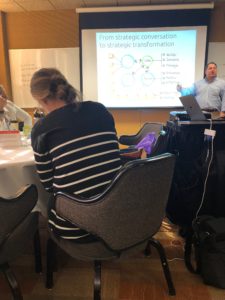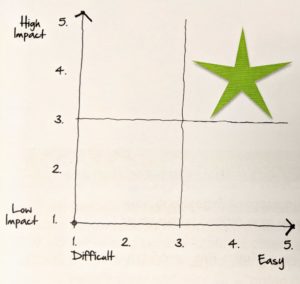Northern Lakes Economic Alliance • info@northernlakes.net • www.northernlakes.net
Andy Hayes, NLEA President
 NLEA Team took part in Strategic Doing Workshop hosted by MSU Extension which taught the practice of collaborative leadership to move action items forward.
NLEA Team took part in Strategic Doing Workshop hosted by MSU Extension which taught the practice of collaborative leadership to move action items forward.
Like many organizational planning sessions, a group is hired to come in and help write a strategic plan and after hours of work the question still remains, “how do we implement this?” Oftentimes a plan either doesn’t have a sense of purpose, or it wasn’t specific enough for anyone to carry out.
To add to this lack of purpose, meetings are often ineffective: 73 percent of employees do other work in meetings and 75 percent of individuals have no formal training to run a meeting.
The problem is that our meetings and collaborative groups today are no longer hierarchical, chain-of-command type settings, and often there is nothing in place to make sure group members are accountable for work they do or don’t do. “Instead of our old habits of command and control, we have to figure out how to align and activate a network of people and organizations;” this is the concept behind Strategic Doing.
At its root, Strategic Doing can propel a small, focused group to bring something to the table and each have a role in making a project happen. With 10 simple rules, your meetings and plans can be transformed:
- Create and maintain a safe space for deep, focused conversations. Identify the core group of 6 action oriented individuals and meet in a space that will foster discussion.
- Frame conversation around appreciative question. Positive problem solving. Imagine if your community could be X? What would that look like?
- Uncover hidden assets among the group. Have everyone share what they bring to the table, strengths, connections, and project ideas.
- Link and leverage your assets to create new opportunities. You may notice aligned interests or project ideas forming, or discover contacts that could help make projects possible. Combine the group assets and you can move a project forward easier.
- Rank all your opportunities to find your “Big Easy.” This is the idea which will impact the most people in your community, and is relatively easy to implement. Rank the ease and impact of the projects on your list. First, each person evaluates the potential impact if it were completely successful with 5 being high and 1 being low. Next, each person evaluates how easy or difficult it would be with 5 being easy and 1 being difficult. Add everyone’s numbers then total impact and ease scores to find your “Big Easy.”

5. Finding your “Big Easy”
- Convert your “Big Easy” into an outcome with measurable characteristics. What would people see, how would they feel, and how would their lives be different?
- Define at least one Pathfinder Project with guideposts. This is your pilot project to help you test some assumptions that could be completed within approximately 3 to 6 months. (Could be phase one of your project to create an initial buzz)
- Draft an action plan with everyone taking a small step. What will each member in the group do in the next 30 days? Everyone must contribute at least an hour of their time to a part of the project, and document their contribution to the group.
- Set a 30/30 meeting to review progress. What has been done in the last 30 days, and what needs to happen in the next 30?
- Nudge, connect, and promote relentlessly to build your new habits of collaboration. Keep each other accountable and get to work.
Interested in learning more about Strategic Doing, visit their website and email or call NLEA at info@northernlakes.net, 231-582-6482.







